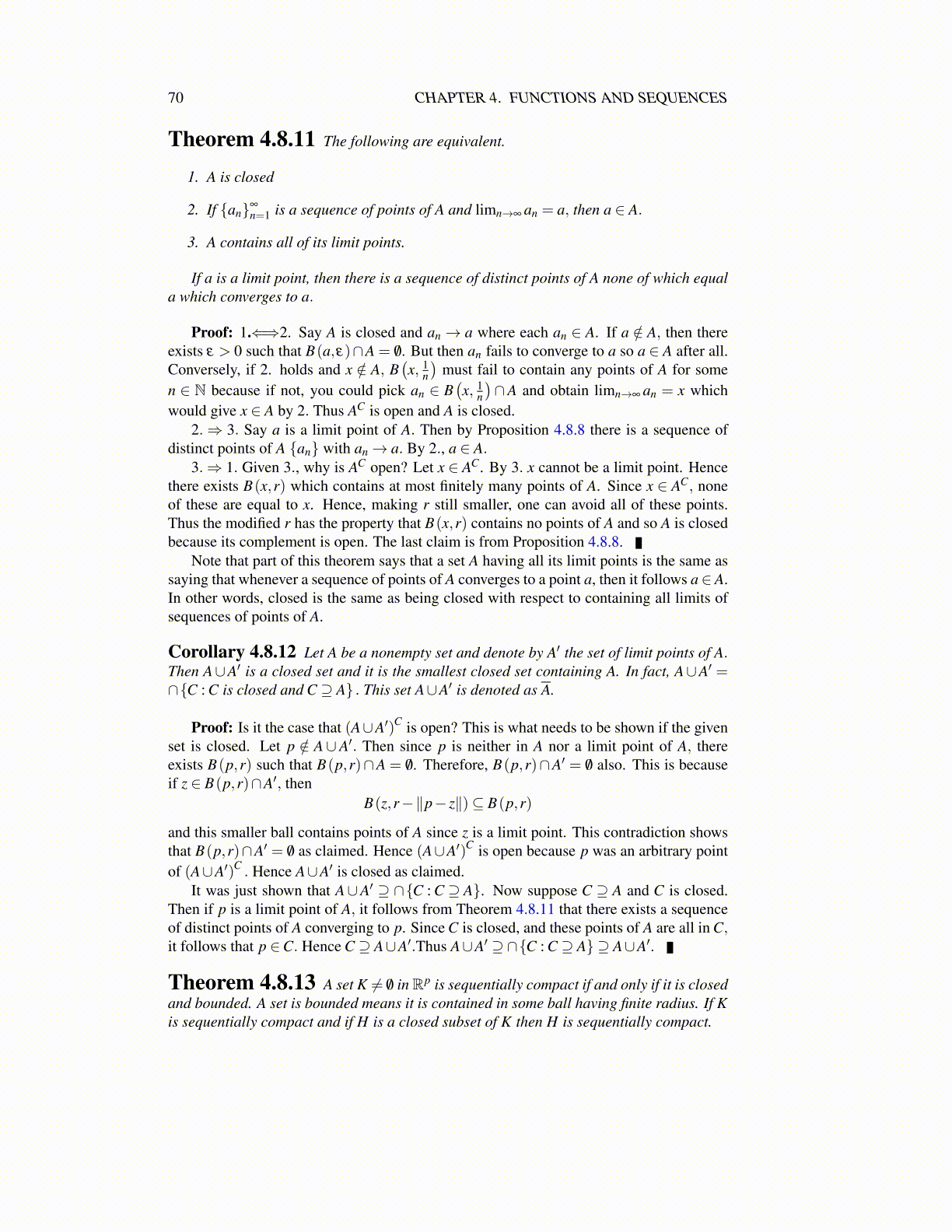
70 CHAPTER 4. FUNCTIONS AND SEQUENCES
Definition 4.8.15 A set K is called compact if whenever C is a collection of opensets such that K ⊆∪C , there exists a finite subset of open sets {U1, · · · ,Um} ⊆ C such thatK ⊆ ∪m
i=1Ui. In words, it says that every open cover admits a finite subcover.
Lemma 4.8.16 If K is a compact set and H is a closed subset of K, then H is alsocompact.
Proof: Let C be an open cover of H. Then HC,C is an open cover of K. It follows thatthere are finitely many sets of C ,
{U j}m
j=1 such that HC∪∪mj=1Ui ⊇ K. Therefore, since no
points of H are in the open set HC, it follows that ∪mj=1Ui ⊇ H.
Now here is the main result, often called the Heine Borel theorem.
Theorem 4.8.17 Let K be a nonempty set in Fp. Then the following are equivalent.
1. K is compact
2. K is closed and bounded
3. K is sequentially compact.
Proof: It was shown above in Theorem 4.8.14 that 2. ⇐⇒ 3. Consider 3.⇒ 1. If Cis an open cover of K, then I claim there exists δ > 0 such that if k ∈ K, then B(k,δ )⊆Ufor some U ∈ C . This δ is called a Lebesgue number. If not, then there exists kn ∈ K suchthat B
(kn,
1n
)is not contained in any set of C because 1/n is not a Lebesgue number. Then
by sequential compactness, there is a subsequence, still denoted by kn which converges tok ∈ K. Now B(k,δ )⊆U for some δ > 0 and some U ∈ C . However, this is a contradictionbecause for n large, 1
n < δ
2 and kn ∈ B(
k, δ
2
)so B
(kn,
1n
)⊆ B(k,δ )⊆U which is a contra-
diction. Consider {B(k,δ ) : k ∈ K} . Finitely many of these sets contain K in their unionsince otherwise, there would exist a sequence {kn} such that ∥kn− km∥ ≥ δ for all m ̸= nand so it cannot have any Cauchy subsequence. Hence K would fail to be compact. ThusK ⊆∪m
i=1B(ki,δ ) for suitable finite set {ki} . Pick Ui ∈ C with Ui ⊇ B(ki,δ ). Then {Ui}mi=1
is an open cover.It remains to verify that 1.⇒ 2. Suppose that K is compact. Why is it closed and
bounded? Suppose first it is not closed. Then there exists a limit point p which is not in K.If x ∈ K, then there exists open Ux containing x and Vx containing p such that Ux∩Vx = /0.Since K is compact, there are finitely many of these Ux which cover K. Say {Ux1 , ...,Uxn} .Then let U = ∪iUxi ,V = ∩Vxi , an open set. Hence p ∈ V and V contains no points of K.Thus p is not a limit point after all. To see that K is bounded, pick k0 ∈ K and consider{B(k0,n)}∞
n=1 . This is an open cover of K and the sets are increasing so one of these ballscovers K. Hence K is bounded.
4.8.4 Complete SeparabilityBy Theorem 2.7.9, the rational numbers are dense in R. They are also countable becausethere is an onto map from the Cartesian product of the two countable sets Z and Z\{0} tothe rationals. Indeed, if m/n is a rational number you consider the ordered pair (m,n) inZ×Z\{0} and let f ((m,n))≡m/n. Thus, it is possible to enumerate all rational numbers.Of course, as shown earlier, this means there exists a one to one mapping fromN ontoQ butthis is not important here. The only thing which matters is that you can write Q= {ri}∞
i=1.Now the following is the important theorem.